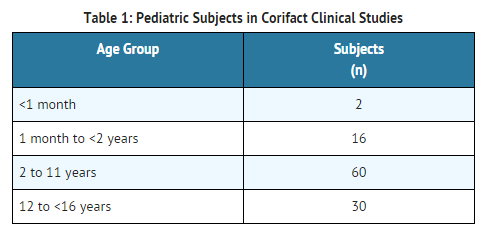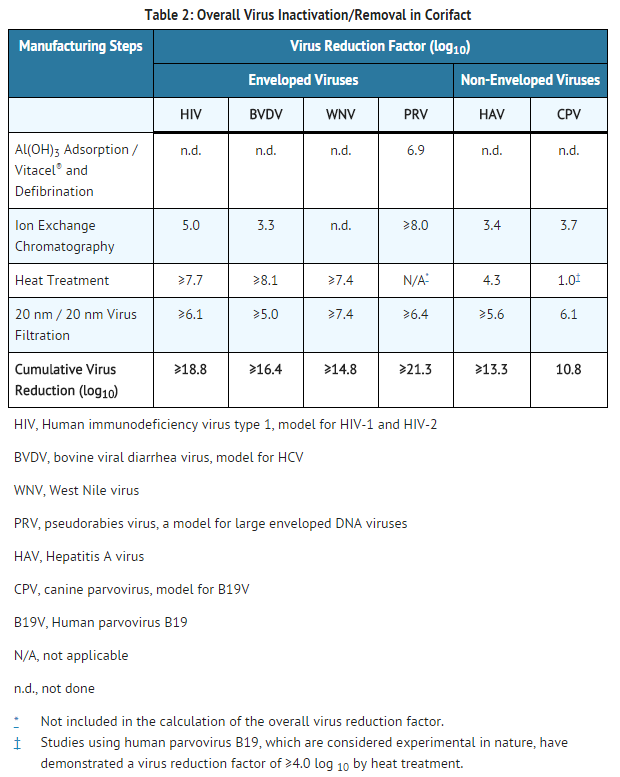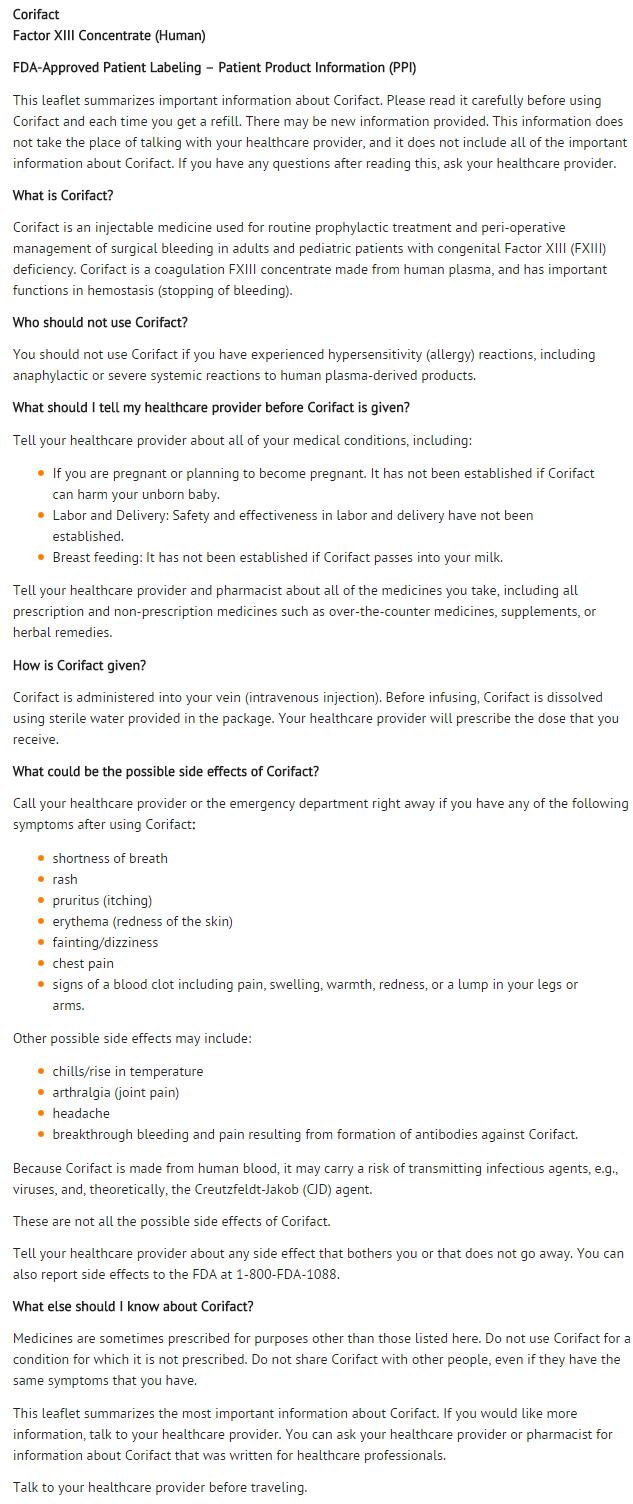Factor XIII concentrate
Editor-In-Chief: C. Michael Gibson, M.S., M.D. [1]; Associate Editor(s)-in-Chief: Rabin Bista, M.B.B.S. [2]
Disclaimer
WikiDoc MAKES NO GUARANTEE OF VALIDITY. WikiDoc is not a professional health care provider, nor is it a suitable replacement for a licensed healthcare provider. WikiDoc is intended to be an educational tool, not a tool for any form of healthcare delivery. The educational content on WikiDoc drug pages is based upon the FDA package insert, National Library of Medicine content and practice guidelines / consensus statements. WikiDoc does not promote the administration of any medication or device that is not consistent with its labeling. Please read our full disclaimer here.
Overview
Factor XIII concentrate is a hemostatic that is FDA approved for the treatment of congenital Factor XIII deficiency. Common adverse reactions include joint inflammation, hypersensitivity, rash, pruritus, erythema, hematoma, arthralgia, headache, elevated thrombin-antithrombin levels, and increased blood lactate dehydrogenase.
Adult Indications and Dosage
FDA-Labeled Indications and Dosage (Adult)
Indications
- Corifact is a Factor XIII concentrate indicated for adult and pediatric patients with congenital Factor XIII deficiency for:
- Routine prophylactic treatment
- Peri-operative management of surgical bleeding
Dosage
- 40 International Units (IU) per kg body weight at a rate not to exceed 4 mL per minute
- Adjust dose ±5 IU per kg to maintain 5% to 20% trough level of FXIII activity as provided in the example below

Off-Label Use and Dosage (Adult)
Guideline-Supported Use
There is limited information regarding Off-Label Guideline-Supported Use of Factor XIII concentrate in adult patients.
Non–Guideline-Supported Use
There is limited information regarding Off-Label Non–Guideline-Supported Use of Factor XIII concentrate in adult patients.
Pediatric Indications and Dosage
FDA-Labeled Indications and Dosage (Pediatric)
Indications
- Corifact is a Factor XIII Concentrate indicated for routine prophylactic treatment and peri-operative management of surgical bleeding in adult and pediatric patients with congenital FXIII deficiency.
Dosage
- 40 International Units (IU) per kg body weight at a rate not to exceed 4 mL per minute
- Adjust dose ±5 IU per kg to maintain 5% to 20% trough level of FXIII activity
Off-Label Use and Dosage (Pediatric)
Guideline-Supported Use
There is limited information regarding Off-Label Guideline-Supported Use of Factor XIII concentrate in pediatric patients.
Non–Guideline-Supported Use
There is limited information regarding Off-Label Non–Guideline-Supported Use of Factor XIII concentrate in pediatric patients.
Contraindications
- Corifact is contraindicated in patients with known anaphylactic or severe systemic reactions to human plasma-derived products
Warnings
Hypersensitivity
- Hypersensitivity reactions have been observed with Corifact. If signs or symptoms of anaphylaxis or hypersensitivity reactions (including urticaria, rash, tightness of the chest, wheezing, hypotension) occur, immediately discontinue administration and institute appropriate treatment.
Immunogenicity
- Development of inhibitory antibodies against FXIII has been detected in patients receiving Corifact. Monitor patients for development of inhibitory antibodies. Presence of inhibitory antibodies may manifest as an inadequate response to treatment. If expected plasma FXIII activity levels are not attained, or if breakthrough bleeding occurs while receiving prophylaxis, perform an assay that measures FXIII inhibitory antibody concentrations.
Thromboembolic Risk
- Thromboembolic complications have been reported. Monitor patients with known risk factors for thrombotic events.
Transmission of Infectious Agents
- Corifact is made from human plasma. Because this product is made from human blood, it may carry a risk of transmitting infectious agents, e.g., viruses, and theoretically, the Creutzfeldt-Jakob disease (CJD) agent. This also applies to unknown or emerging viruses and other pathogens.
- All infections thought by a physician to have been possibly transmitted by this product are to be reported by the physician or other healthcare provider to the CSL Behring Pharmacovigilance Department at 1-866-915-6958 or FDA at 1-800-FDA-1088 or www.fda.gov/medwatch.
Monitoring Laboratory Tests
- Monitor patient's trough FXIII activity level during treatment with Corifact
- If breakthrough bleeding occurs, or if expected peak plasma FXIII activity levels are not attained, perform an investigation to determine the presence of FXIII inhibitory antibodies
Adverse Reactions
Clinical Trials Experience
- The most common adverse reactions reported in frequency >1% are joint inflammation, hypersensitivity, rash, pruritus, erythema, hematoma, arthralgia, headache, elevated thrombin-antithrombin levels, and increased blood lactate dehydrogenase.
- The serious adverse reactions, reported in one subject each (frequency 0.5%), were hypersensitivity, acute ischemia, and neutralizing antibodies against FXIII.
Clinical Trials Experience
- Because clinical trials are conducted under widely varying conditions, adverse reaction rates observed in the clinical trials of a drug cannot be directly compared to rates in the clinical trials of another drug and may not reflect the rates observed in practice.
- Twelve clinical studies included a total of 188 subjects, 108 subjects were <16 years of age and a total of approximately 4314 infusions of Corifact were administered in the studies.
Efficacy and Safety Study
- A 12-month, prospective, open-label, multicenter efficacy and safety study was conducted in 25 males and 16 females ranging in age from less than 1 year to 42 years old (2 infants, 8 children, 8 adolescents, and 23 adults). There were no reports of deaths, life-threatening events, or adverse events that led to discontinuation or withdrawal from the study. Four subjects received FXIII in the peri-operative setting, and no treatment-related AEs were reported. An additional subject was pre-treated with plasma and experienced a hypersensitivity reaction.
Immunogenicity
- A case of neutralizing antibodies against FXIII was reported in the postmarketing clinical study. The patient received prophylactic treatment with Corifact for ten years. Concomitant medications included interferon for hepatitis C infection. This patient presented with bruising, and post-infusion FXIII levels were found to be lower than expected. Over several weeks, FXIII recovery values decreased, so the dose and frequency of treatments were increased. Neutralizing antibodies to FXIII were detected, interferon treatment was discontinued, and the subject underwent plasmapheresis. Within a month, neutralizing antibodies were no longer detectable, FXIII recovery levels improved, and the previous prophylactic regimen was resumed.
Postmarketing Experience
There is limited information regarding Postmarketing Experience of Factor XIII concentrate in the drug label.
Drug Interactions
There is limited information regarding Factor XIII concentrate Drug Interactions in the drug label.
Use in Specific Populations
Pregnancy
- Animal reproduction studies have not been conducted with Corifact. Safety and effectiveness in pregnancy have not been established. It is also not known whether Corifact can cause fetal harm when administered to a pregnant woman or can affect reproduction capacity. Corifact should be given to a pregnant woman only if clearly needed.
- Australian Drug Evaluation Committee (ADEC) Pregnancy Category
There is no Australian Drug Evaluation Committee (ADEC) guidance on usage of Factor XIII concentrate in women who are pregnant.
Labor and Delivery
Corifact has not been studied for use during labor and delivery. Safety and effectiveness in labor and delivery is unknown.
Nursing Mothers
It is not known whether Corifact is excreted in human milk. Because many drugs are excreted in human milk, caution should be exercised when Corifact is administered to a nursing woman.
Pediatric Use
Of the 188 subjects in the Corifact clinical studies, 108 were subjects <16 years of age at the time of enrollment
- In the pharmacokinetic study [see CLINICAL PHARMACOLOGY (12.3)], 5 of the 14 subjects ranged in age from 2 to <16 years. Subjects less than 16 years had a shorter half-life (5.7 ± 1.00 days) and faster clearance (0.29 ± 0.12 mL/hr/kg) compared to adults (half-life: 7.1 ± 2.74 days, clearance: 0.22 ± 0.07 mL/hr/kg). Dose adjustments may be needed for patients <16 years of age. There were no differences in the safety profile in children as compared to adults.
Geriatic Use
The safety and efficacy of Corifact in the geriatric population have not been established.
Gender
There is no FDA guidance on the use of Factor XIII concentrate with respect to specific gender populations.
Race
There is no FDA guidance on the use of Factor XIII concentrate with respect to specific racial populations.
Renal Impairment
There is no FDA guidance on the use of Factor XIII concentrate in patients with renal impairment.
Hepatic Impairment
There is no FDA guidance on the use of Factor XIII concentrate in patients with hepatic impairment.
Females of Reproductive Potential and Males
There is no FDA guidance on the use of Factor XIII concentrate in women of reproductive potentials and males.
Immunocompromised Patients
There is no FDA guidance one the use of Factor XIII concentrate in patients who are immunocompromised.
Administration and Monitoring
Administration
Monitoring
- Monitor patient's FXIII activity levels during and after surgery
- Monitor patients for development of inhibitory antibodies.
- Monitor patient's trough FXIII activity level during treatment with Corifact
IV Compatibility
There is limited information regarding IV Compatibility of Factor XIII concentrate in the drug label.
Overdosage
There is limited information regarding Overdose of Factor XIII concentrate in the drug label.
Pharmacology
There is limited information regarding Factor XIII concentrate Pharmacology in the drug label.
Mechanism of Action
- Corifact (FXIII) is an endogenous plasma glycoprotein consisting of two A-subunits and two B-subunits. FXIIIa promotes cross-linking of fibrin during coagulation and is essential to the physiological protection of the clot against fibrinolysis. FXIIIa is a transglutaminase enzyme that catalyzes the cross-linking of the fibrin α- and γ-chains for fibrin stabilization and renders the fibrin clot more elastic and resistant to fibrinolysis.1,2 FXIIIa also cross-links α2-plasmin inhibitor to the α-chain of fibrin, resulting in protection of the fibrin clot from degradation by plasmin. Cross-linked fibrin is the end result of the coagulation cascade, and provides tensile strength to a primary hemostatic platelet plug.2
- The B-subunits in plasma have no enzymatic activity, and function as carrier molecules for the A-subunits. They stabilize the structure of the A-subunits and protect them from proteolysis.
Structure
- Corifact, Factor XIII Concentrate (Human), is a heat-treated, lyophilized concentrate of coagulation factor XIII for reconstitution for intravenous use. Corifact (FXIII) consists of two A-subunits and two B-subunits, and is made from pooled human plasma. Each vial contains 1000-1600 units FXIII, 120 to 200 mg human albumin, 120 to 320 mg total protein, 80 to 120 mg glucose and 140 to 220 mg sodium chloride. Sodium hydroxide may have been used to adjust the pH.
- All plasma used in the manufacture of Corifact is obtained from US donors and is tested using serological assays for hepatitis B surface antigen and antibodies to HIV-1/2 and HCV. The plasma is tested with Nucleic Acid Testing (NAT) for HCV, HIV-1, HAV and HBV and found to be non-reactive (negative), and the plasma is also tested by NAT for Human Parvovirus B19. Only plasma that passed virus screening is used for production, and the limit for Parvovirus B19 in the fractionation pool is set not to exceed 104 International Units of Parvovirus B19 DNA per mL.
- Corifact is manufactured from cryo-depleted plasma into an ethanol precipitate, which is then purified by the following four steps:
Precipitation/adsorption
Ion exchange chromatography Heat-treatment (+60°C for 10 hours in an aqueous solution) Virus filtration over two 20 nm filters in series The sterile filtered final bulk solution is filled into vials and lyophilized. These four manufacturing steps were independently validated in a series of in vitro experiments for their capacity to inactivate or remove both enveloped and non-enveloped viruses. Table 2 shows the virus clearance capacity of the Corifact manufacturing process, expressed as mean log10 reduction factor.
Pharmacodynamics
There is limited information regarding Pharmacodynamics of Factor XIII concentrate in the drug label.
Pharmacokinetics
- A 12-week prospective, open-label, multicenter pharmacokinetic and safety study was conducted in 7 females and 7 males with congenital FXIII deficiency, ranging in age from 5 to 42 years (3 children, 2 adolescents, 9 adults). One adult male did not complete the pharmacokinetic study.
- Each subject received 40 units per kg Corifact intravenously every 28 days for a total of three doses administered at approximately 250 units per minute. Blood samples for doses 1 and 2 were drawn from patients to determine the FXIII activity level at baseline and 30 and 60 minutes after the infusion. Following the infusion of the third dose of Corifact, blood samples were drawn at regular intervals up to 28 days to determine the pharmacokinetic parameters. The mean increase in FXIII activity levels was 83% with a range of 48 to 114% over the baseline after the third dose. The pharmacokinetic parameters based on baseline adjusted FXIII activity (Berichrom assay) are shown in TABLE 3.
Nonclinical Toxicology
Animal Toxicology and/or Pharmacology
- Corifact was studied in an acute toxicity study in mice and rats at doses up to 3550 units per kg and 1420 units per kg, respectively. Repeat dose toxicity was studied in rats at daily doses up to 350 units per kg for a period of 14 days. No signs of toxicity were observed in the single dose and repeat dose studies.
- A local tolerance study in rabbits demonstrated no clinical or histopathological changes at the injection site after intravenous, intra-arterial or para-venous administration of Corifact.
- A thrombogenicity test was performed in rabbits at doses up to 350 units per kg. Corifact showed no thrombogenic potential at the doses tested.
Clinical Studies
- The postmarketing efficacy and safety trial conducted in 41 subjects who received routine prophylactic treatment (40 U/kg every 28 days for 52 weeks) for congenital FXIII deficiency, was to verify the clinical benefit of Corifact by showing correlation between trough levels of FXIII activity and clinical efficacy. The clinical benefit of Corifact was also demonstrated by comparing the incidence of bleeding in Corifact-treated subjects to historical control with congenital FXIII deficiency.
- The incidence of spontaneous bleeding episodes requiring treatment was evaluated. Treatment was defined as an administration of a FXIII-containing product to treat the bleeding episode. None of the 5 subjects who experienced a spontaneous bleeding episode (2 nose bleeds, 2 rectal bleeds, and 1 episode of hematuria associated with a urinary tract infection, and an indwelling urinary catheter) required treatment with a FXIII-containing product.
- An annualized bleeding rate of 0 episodes per subject per year for spontaneous bleeding was established when compared to a historical annualized bleeding rate of 2.5 episodes per subject per year in patients receiving on-demand treatment of acute bleeding in patients with congenital FXIII deficiency.3
- Eight bleeding episodes secondary to trauma, and one associated with surgery were also reported during the 52 weeks of the trial. In the eight bleeding episodes secondary to trauma, six did not require treatment with a FXIII-containing product, and two were successfully treated with a FXIII-containing product (one was treated with Corifact and one with plasma).
- The prophylactic administration of Factor XIII Concentrate (Human) every 28 days in subjects with congenital FXIII deficiency achieved mean FXIII activity levels between 5% and 20%. FXIII activity was maintained at ≥5% in ≥97% of subjects and ≥10% in ≥85% of subjects. Of the 533 doses administered to 41 subjects, dose adjustment was required on only eight occasions, supporting that 40 U/kg every 28 days is the appropriate dose for the majority of patients.
- Five subjects underwent surgical procedures, four were elective and one was an emergency. Of the four elective surgeries, three subjects received Corifact prior to surgery (0 to 7 days prior to surgery) with no post-operative bleeding. One subject who received Corifact 7 days prior to surgery experienced bleeding post-extraction of all four wisdom teeth. The bleeding was stopped four hours after the oral surgery with an additional dose of Corifact (50% of the subject's routine dose). One subject who required emergency surgery was pre-treated with plasma.
How Supplied
- 1000-1600 units* 63833-518-02
Corifact in a single-use vial [NDC 63833-528-01] 20 mL vial of Sterile Water for Injection, USP [NDC 63833-734-65] Mix2Vial filter transfer set Alcohol swab
The actual units of potency of FXIII Concentrate (Human) are stated on each Corifact vial label and carton.
Storage
- Refrigerate Corifact at 2-8°C (36-46°F). Keep in original carton to protect from light. Do not freeze.
- Corifact is stable for 24 months, up to the expiration date on the carton and vial labels. Within the expiration date, Corifact may be stored at room temperature not to exceed 25°C (77°F) for up to 6 months.
- Do not return the product to the refrigerator after it is stored at room temperature. Clearly mark the beginning date of room temperature storage on the carton label.
- Do not use beyond the expiration date on the carton and vial labels, or end of the period for room temperature storage, whichever comes first.
This product does not contain a preservative and must be used within 4 hours after reconstitution. Do not refrigerate or freeze the reconstituted solution.
Images
Drug Images
{{#ask: Page Name::Factor XIII concentrate |?Pill Name |?Drug Name |?Pill Ingred |?Pill Imprint |?Pill Dosage |?Pill Color |?Pill Shape |?Pill Size (mm) |?Pill Scoring |?NDC |?Drug Author |format=template |template=DrugPageImages |mainlabel=- |sort=Pill Name }}
Package and Label Display Panel
PRINCIPAL DISPLAY PANEL
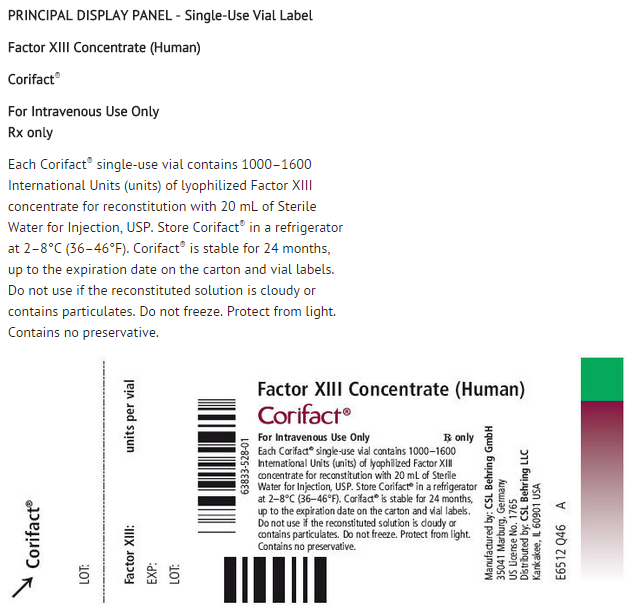
This image is provided by the National Library of Medicine. 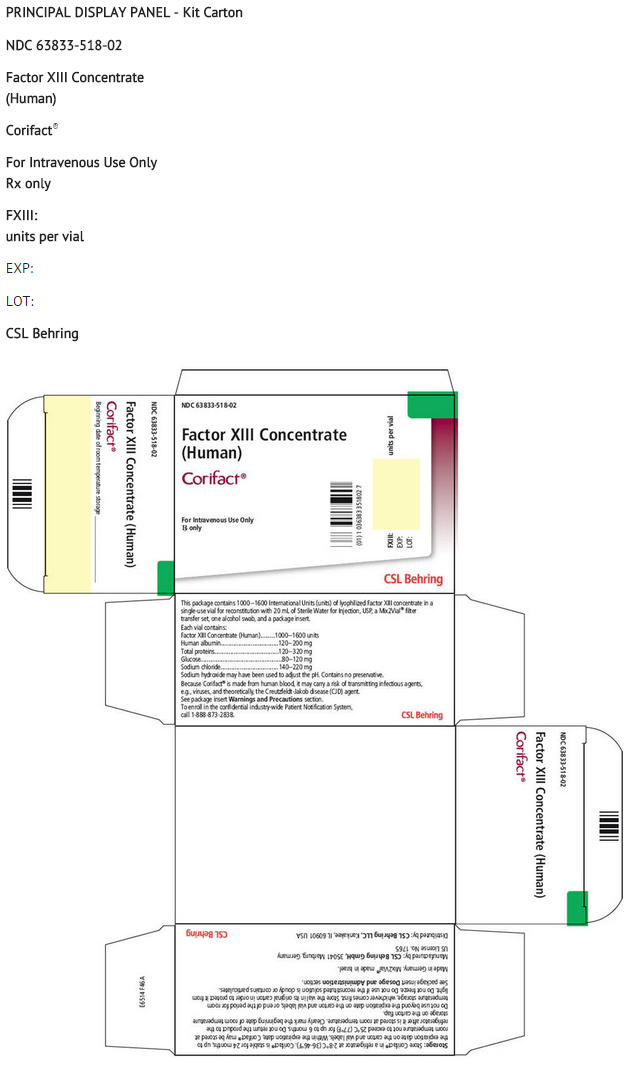
This image is provided by the National Library of Medicine.
Ingredients and Appearance
{{#ask: Label Page::Factor XIII concentrate |?Label Name |format=template |template=DrugLabelImages |mainlabel=- |sort=Label Page }}
Patient Counseling Information
- Inform patients of the signs and symptoms of allergic hypersensitivity reactions, such as urticaria, rash, tightness of the chest, wheezing, hypotension and/or anaphylaxis experienced during or after injection of Corifact
Inform patients of the signs and symptoms of immunogenicity such as breakthrough bleeding Inform patients of signs and symptoms of thrombosis, such as limb or abdomen swelling and/or pain, chest pain, shortness of breath, loss of sensation or motor power, altered consciousness, vision, or speech [see WARNINGS AND PRECAUTIONS (5.3)]. Inform patients that because Corifact is made from human blood, it may carry a risk of transmitting infectious agents, e.g., viruses, and theoretically, the Creutzfeldt-Jakob disease (CJD) agent
PATIENT PACKAGE INSERT
Precautions with Alcohol
- Alcohol-Factor XIII concentrate interaction has not been established. Talk to your doctor about the effects of taking alcohol with this medication.
Brand Names
- CORIFACT®[1]
Look-Alike Drug Names
- There is limited information regarding the look alike drug names.
Drug Shortage Status
Price
References
The contents of this FDA label are provided by the National Library of Medicine.
